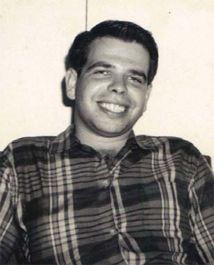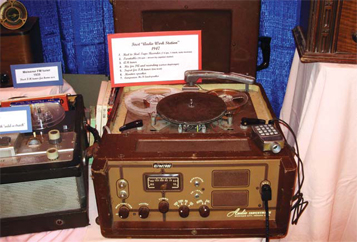SCN:How did your 52 years in the music, professional audio, and radio industries begin?
Bob Casey: Since about the age of 10, I always knew what I wanted to do. I clearly remember as far back as age 4, seeing the large PA horns on top of my father, Edward P. Casey, Sr.’s sound truck. For the next 13 years I would take every available chance to go down to my father’s place of business and just hang around.
SCN:You attribute the construction of the very first DJ “coffin” in 1955 to your father. How did he come up with such a thing, and how did you end up using it at a Record Hop in 1958?
BC: Back around 1955, my father’s company was at the top of its game filling churches, schools and the surrounding grounds like football fields with tremendous high quality sound—and he was doing this years before anybody else even dreamt of it.
On one occasion, he had to provide recorded music (“Ave Maria”) for a very long procession at Mount St Mary’s School in the Bronx. He designed and built this big box that had two Stromberg-Carlson 3-speed turntables, two Astatic 16-inch tonearms, two volume controls, and a simple toggle switch. As the first record would end, the switch would be thrown and the second record, which was already spinning, would kick in. I was 12 years old and I remember watching it work perfectly for that occasion. Dad never had a need for it again and it sat up in the attic above the offices.
Three years later, I asked Dad if I could ‘borrow’ the big blue box for a dance. With my dual turntables, a 20- watt Masco tube amplifier, two University BLC Hi-Fi horns, my Crystal microphone, and my Ultratone tape recorder, I spent the next six years running some of the best dances anywhere, as well as supplying hours of taped music for private parties in basements and country clubs.
Casey’s father purchased this Ultratone unit by Audio Industries from Terminal Radio on ‘Radio Row’ in lower Manhattan in December 1946. It is considered one of the first home model tape recorders. By 1961 I was running dances for packed houses in Yonkers, White Plains, and Port Chester. At the same time I was failing miserably in school. In June 1961, I entered the U.S. Army and for the next five years I spent time far away from my loves of radio, records and sound systems.
In 1968, I failed the audition of Armed Forces Radio so badly, they hired me I think, for the comedy relief. Within six months I became the head of production for the American Forces Vietnam Network. I produced and hosted the first “oldies” show on Armed Forces Radio, which became one of the most popular shows in Vietnam in 1969. For my last few months in-country, I toured many of the bases with the USO.
When I returned home, I had a job waiting for me at WMCA as producer of Dan Daniel’s Morning. After a year I moved to WNBC and NBC Radio and TV network. I starting my sound company in 1972, but continued to dabble in radio and a few local stations in Dutchess County, NY, where I now live.
SCN: Do you think a sound man ever really “retires”?
BC: Absolutely not. As a fisherman will always want to know what lure was used to catch a prize trout or a mechanic wants to know what is under the hood of a car that just won a race, so too, a sound man will always want to know what mics were being used or what speakers are in a certain cluster or array of a good system
Whether I’m at a Broadway show, in a church, or at a large concert, I’m always interested, almost to the point of distraction, in what is being used to create the sound that I’m listening to. If it is good sound, then curiosity will drive me to learn how it was achieved. If it is bad sound, then my mind reels with different ways to make it better.

Casey produced and hosted the first “oldies” show on Armed Forces Radio, which became one of the most popular shows in Vietnam in 1969.
How would you complete the following sentences?
A passion for audio begins... with a developing interest in what sounds good. Without that premise, your business in the sound world will not rise above the state of mediocrity.
The march of progress in audio technology... is mind boggling! Just look at the advances in wireless microphones in the past 10 years, the advances in digital processing for feedback suppression in the past five years, the accomplishments in signal processing and speaker management during the same period of time. Just look at the audio consoles being used in houses of worship today. Broadway shows and many rock concerts didn’t have this quality 10 years ago. Truly, the advances in audio technology today are right up there with other major industries relying on the digital domain for advances, such as science and medicine.
Yet for all that technology, I feel that the faults of the audio industry still lie with the people who select and place the loudspeakers and the microphones without regard for the room acoustics, and more importantly, the intended use and environment of the equipment. No school, no book, no computer program, no truck full of high-end audio gear will replace knowledge gained from years of experience and on-site job training.
From the earliest days of my career I knew... that this was what I wanted to do. I wanted to follow my father but also wanted to take things in a different direction. From the early days of the Record Hops, thru the discos and cabarets, up to St. Patrick’s Cathedral and Rockefeller Center, I’ve enjoyed the show business end of sound. I’ve done the sound for countless celebrities and dignitaries. I’ve been witness to moments in history—The Pope at Yankee Stadium, political rallies by President Carter and President Reagan. I have been so lucky and wouldn’t change it for anything. I wouldn’t want to do it over again, but I wouldn’t change it.










